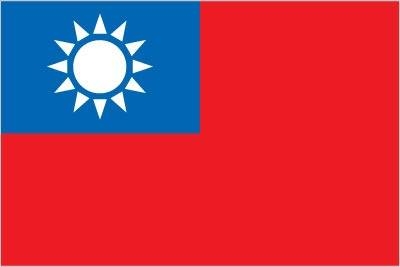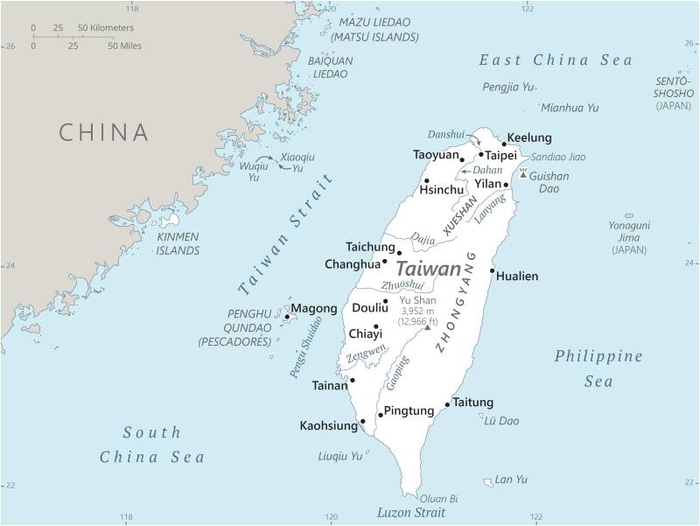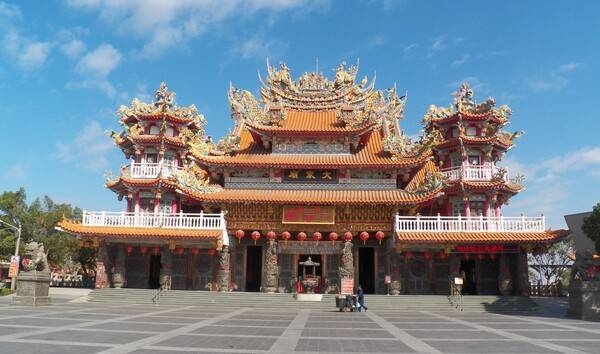137 Taiwan (China)

Red field with a dark blue rectangle in the upper hoist-side corner bearing a white sun with 12 triangular rays. The blue and white design of the canton (symbolizing the sun of progress) dates to 1895. It was later adopted as the flag of the Kuomintang Party. Blue signifies liberty, justice, and democracy, red stands for fraternity, sacrifice, and nationalism, and white represents equality, frankness, and the people’s livelihood. The 12 rays of the sun are those of the months and the twelve traditional Chinese hours (each ray equals two hours).
Flag courtesy of the CIA World Factbook

Map courtesy of the CIA World Factbook

Sicao Dazhong Temple, located in Taijiang National Park, honors a Taiwanese general of Koxinga, known as Chen Tze. A fearless warrior, he defeated over 300 Dutch soldiers in one encounter and won numerous other battles during his life. However, after being betrayed by his own people, he drowned himself in the sea. The shrine was established to honor the general, and the title Marshal of the Sea was bestowed posthumously upon him to praise him for his exceptional military service. Sicao Dazhong Temple is three or four centuries old and has been rebuilt several times with the most recent version completed in 1987. The temple roof is a fine example of southern Chinese temple construction style, displaying colorful and animated figures of dragons, lions, and phoenixes boldly lining the elaborate three-tiered roof’s corners and edges.
Photo courtesy of the CIA World Factbook
Last updated on December 1, 2025
Government
According to Britannica, Taiwan had no central governing authority until the Dutch colonized the island in the 1620s. The Dutch era lasted only about 40 years, however, and Taiwan became the first place ever to free itself from Western colonial rule. Subsequently, Taiwan was self-governing, but for only a few decades. Taiwan was then made part of China for two centuries, after which it was a colony of Japan from 1895 to 1945.
With the end of World War II, in 1945, Taiwan was again made part of China, but that arrangement lasted for only four years. In 1949, after the Chinese communists had defeated the Nationalist government on the mainland, the Nationalist leader Chiang Kai-shek moved his government, party, and military to Taiwan. Taiwan, as the Republic of China, represented China in the United Nations until 1971, when the People’s Republic (the regime established by the communists on the mainland was called the People’s Republic of China) took the China seat. Subsequently, Chiang’s government quickly lost its international standing.
Chiang’s government, a mix of presidential, parliamentary, and cabinet models, was based on the constitution promulgated in 1947. However, it worked more as a presidential system, since political power resided largely in the Nationalist Party, or Kuomintang (KMT), over which Chiang presided. A set of “Temporary Provisions” (to the 1947 constitution, rescinding some parts of it) and an emergency decree (characterized by some as martial law) were enacted in 1948 and 1949, respectively, while the Nationalists were still at war on the mainland. The result was a political system that was democratic in form but not very much so in operation.
The government, the police system, the education system, and the military (at the top) were staffed mainly by mainland Chinese who had moved to Taiwan from China after World War II. Hakkas, a local minority that had migrated centuries earlier, whom the mainland Chinese trusted more than the Fukien Taiwanese, assumed positions in the police forces and the railroads. Fukien Taiwanese, Taiwan’s largest ethnic group, comprising about two-thirds of the population, gradually assumed positions in business and local government.
Democratization in Taiwan was introduced in local politics first and favored the Taiwanese, especially the Fukien Taiwanese. By the 1980s, Taiwan had made significant strides toward establishing a working democracy. In 2000 the ruling KMT was defeated in the presidential election by the candidate of the Democratic Progressive Party (DPP), whose base consisted of Fukien Taiwanese. In an election the next year, the DPP won the largest number of seats in Taiwan’s legislature (the Legislative Yuan).
While ethnicity became less of an issue in most respects than it had been in the past, as a result of intermarriage, social change, and urbanization, it continued to play a role in politics, especially during elections. Nevertheless, the KMT regained the presidency and won a majority in the legislature in 2008, on a platform of its being a multiethnic party while advancing better government and ridding politics of the corruption that had plagued the DPP’s Pres. Chen Shui-bian and his party. The DPP rebounded, however, winning both the presidency and a majority of seats in the legislature in 2016.
Taiwan’s 1947 constitution, promulgated while the Nationalist government still ruled the mainland as well as Taiwan, created a republican system of government. The document ensured legislative supremacy and granted a considerable degree of autonomy to local governments. The president, originally chosen by the National Assembly until that body was abolished in 2005, is now elected by popular vote and is head of state. The premier, who is appointed by the president, heads the government. Political parties are not mentioned in the document, although it was assumed that they would play a role in politics.
Instead of the three branches of government that are found in most Western governments, the constitution originally provided for five: the executive, legislative, and judicial components plus a Control Yuan (branch of government) and an Examination Yuan. The two additional branches represented organs of government in traditional China that checked on the bureaucracy and that managed functions such as the civil service examinations and promotions. It was thought that a five-branch system would provide better checks and balances than a three-branch system.
The Temporary Provisions of 1948 gave the president emergency powers, banned the formation of new political parties, and suspended the two-term limit for the president. The 1949 emergency decree granted the military, police, and intelligence bodies broad powers. The two measures truncated constitutional rights and effectively prevented the political system from operating democratically. However, local government was not much affected, nor were economic rights curtailed. The emergency decree was terminated in 1987, and the Temporary Provisions were canceled in 1991.
The constitution was amended a number of times during the 1990s. Until then the government, as the Republic of China, effectively had maintained an electoral college with other powers (the National Assembly) that included representatives from each of the mainland provinces. One of the important changes undertaken in the early part of the decade was the start of a process to get rid of those representatives of China in the elected bodies of government, although overseas Chinese (ethnic Chinese living outside Taiwan and China) were allotted special representation. Other measures included reforms of provincial and local government, equal rights for women, safeguards for the handicapped and the aboriginal peoples, changes in the relationship of the branches of government and the role of the premier, and the start of a process to phase out the National Assembly. In 1993 the Control Yuan ceased to be an elected government body, and its functions were truncated. From early 2005 until mid-2008 it did not function at all, because of a deadlock between the president and the legislature over nominees. The branch has since been reinstated, but it is no longer regarded as an important organ of the government. The Examination Yuan likewise is no longer thought of as a major branch of the government, meaning that Taiwan, for all intents and purposes, has a three-branch system.
In 2003 the legislature passed the Referendum Act, which defined that theretofore unused constitutional provision. Referendums were included in subsequent elections, and some caused considerable controversy. In 2005 the constitution was amended to abolish the National Assembly. The process, however, did not resolve the question of the fundamental structure of the government, though other changes and practice have made it more presidential.
Taiwan’s political system has some of the traits of a federal system, with first or primary jurisdiction belonging to local government in certain realms. In 1992 a constitutional amendment strengthened local government. The way the political system works, in that local politicians can easily make their way to higher positions in the national government, also makes local government more important than it might be otherwise. Finally, many in Taiwan believe that democracy comes from the bottom up and that government reforms more often succeed when starting at the local level. Thus, respect for local government is high.
The administrative units below the national government are special municipalities, counties and provincial municipalities, and county municipalities and townships. Until the late 1990s there was an administratively autonomous Taiwan provincial government, which was headed by a governor and had its own legislature. However, it duplicated most of the national government’s functions. Thus, reforms enacted in the name of efficiency reduced the entity to an agency of the Executive Yuan, and it was progressively diminished in size and function.
Six of Taiwan’s cities are classified as special municipalities and constitute an important segment of local government because of their size and economic importance. Mayors of two of the cities, Taipei and Kao-hsiung (Kaohsiung), have become presidential candidates and presidents, and local elections in the two cities have been important and are thought by some to constitute a bellwether for future national elections. Elections in other cities and in the counties are also considered important.
Taiwan’s Judicial Yuan (the judicial branch of government) is the highest organ in the administration of justice. It is organized into the Council of Grand Justices, three levels of lower courts, administrative courts, and the Committee on the Discipline of Public Functionaries. The Council of Grand Justices has the power of judicial review and hears other important cases that do not involve an interpretation of the constitution. The Supreme Court, which is below the Council of Grand Justices, decides only issues of law.
The 15 members of the Council of Grand Justices are appointed by the president with the approval of the Legislative Yuan. Justices serve a term of eight years and may not serve a second term consecutively. Terms are staggered so that seven or eight new justices are appointed every four years.
In 1980 an act was passed by the legislature that made the judiciary more independent. It is still criticized, however, as not being free enough and not having sufficient power, though Taiwan’s citizens have expressed concern that a more powerful judiciary could sully Taiwan’s democracy. In 2002 the criminal justice system shifted its operating method from a judge-centered inquisitorial system (as in Germany) to an attorney-based adversarial system (like in the United States).
Lawyers and prosecutors have played a much more important role in the judicial process since the late 1980s, though not through becoming judges. Lawsuits have become much more common in Taiwan, an inordinate number stemming from election campaigns. Still, Taiwan would not be called a litigious society.
Civil Aeronautics Administration (CAA)
The Republic of China set out to build its civil aviation industry early after the country was established. In the eighth year of the R.O.C., an aviation governmental agency was already set up to take charge of the country’s aviation affairs. In the 18th year of the R.O.C., the agency became a sub-unit of the Ministry of Transport and Communications. After the Second World War, to develop and manage civil aviation businesses, on January 20, 1947, the Civil Aeronautics Administration was founded in Nanjing under the MTC, listed as a third-rank central governmental agency under the Executive Yuan. The Administration’s rules for organization structure was released on May 10, 1947. In response to a thriving aviation industry and to fulfill the needs of new airline companies, the rules were modified three times, respectively in 1972, 1998 and 2021. As the Administrative Yuan was reorganized in the 2010s, the (draft for) Organization Act of the Civil Aeronautics Administration of the MOTC was drafted. It was sent to the Legislative Yuan for deliberation and at this moment the deliberation is still being carried out.
Airspace
SkyVector – Google Maps – ADS-B Exchange
ICAO countries publish an Aeronautical Information Publication (AIP). This document is divided into three parts: General (GEN), En Route (ENR) and Aerodromes (AD). ENR 1.4 details the types of airspace classes they chose to adopt from classes A through G.
Drone Regulations
Civil Aviation Act & Regulations
07-04A Regulations of Drone (enforced from December 1, 2024.)
07-04A Attachment (enforced from December 1, 2024.)
Advanced Air Mobility (AAM) Regulations & Policies
Bilateral agreements facilitate the reciprocal airworthiness certification of civil aeronautical products imported/exported between two signatory countries. A Bilateral Airworthiness Agreement (BAA) or Bilateral Aviation Safety Agreement (BASA) with Implementation Procedures for Airworthiness (IPA) provides for airworthiness technical cooperation between the FAA and its counterpart civil aviation authorities.
American Institute in Taiwan & The Taipei Economic and Cultural Representative Office
Implementation Procedures for Airworthiness
Letter, 2016 Notification of Part 21 Amendment
Letter, 2016 Notification of Part 23 NPRM
Letter, 2016 Notification of Policy Deviation Memorandum for FAA Order 8130.21H
Obtaining Certification Approval from Taiwan
Advanced Air Mobility (AAM) News
2025
Video courtesy of Advanced Air Mobility Institute from the July 2025 Global AAM Forum.
2025 – SkyDrive Plans Aeromedical eVTOL Flights in Taiwan’s Penghu Islands
2025 – SkyDrive, 7A Drones, ITRI team up for eVTOL services in Taiwan
2025
Video courtesy of Advanced Air Mobility Institute from the January 2025 Global AAM Forum. Complete session for Day 2 of this Forum is available on the Advanced Air Mobility Institute YouTube Channel
Short Essay Questions
Scenario-Based Question
You have been hired by a Drone Startup Company. Your boss has immediately assigned this job to you.
They need you to prepare a one-page memo detailing the legalities of using a drone to film the Temple, pictured above.
They need you to mention any national laws and local ordinances.
They specifically want to know what airspace (insert pictures) you will be operating in and whether or not you need an airspace authorization.
Does it matter whether or not you are a citizen of the country?
Lastly, there is a bonus for you if, as you scroll through this chapter, you find any typos or broken links!
Short Essay Questions
- What are the drone categories?
- How is registration addressed?
- How is remote ID addressed?
- What are the model aircraft rules?
- What are the commercial drone rules?
- Are there waivers or exemptions to the rules? If so, for what?
- Would you share a link to an interactive airspace map?
- How is BVLOS addressed?
- How can you fly drones at night?
- How can you fly drones over people?
- Where do you find drone NOTAMs?
- What are the rules for drone maintenance?
- What are the rules for an SMS program?
- What are some unique rules not mentioned above?
- What are the C-UAS rules?
- What are the AAM rules?

